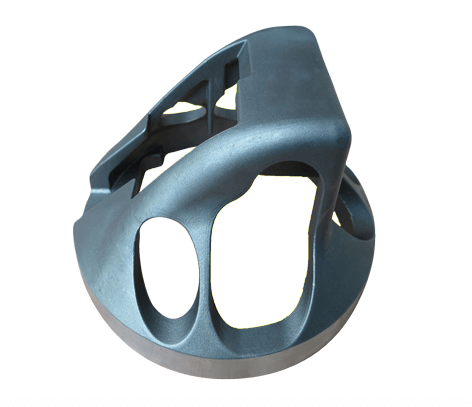Precise railway silica sol castings are a type of investment casting that is widely used in the railway industry. This casting process involves using silica sol (silica solution) as the binder material to build the casting mold. The metal castings produced by silica sol casting have fine surfaces and high accuracy, and the general dimensional tolerance grade is up to CT4 – CT6.
Silica sol process stainless steel casting is an excellent process technology in the foundry industry, with little or no cutting required. It is a casting process that produces castings with higher dimensional accuracy and surface quality than other casting methods, even for complex, high-demanding components. The silica sol casting process is preferred for producing complicated and demanding stainless steel components due to its capacity to make high-quality components with outstanding mechanical qualities and its eco-friendly nature.
Overview of Precise Railway Silica Sol Castings
Definition of Precise Railway Silica Sol Castings
Precise Railway Silica Sol Castings is a casting process that belongs to investment casting or precision casting. It is a casting process with little or no cutting and is an excellent process technology in the foundry industry. The process uses silica sol (silica solution) as the binder material to build the casting mold. The metal castings produced by silica sol casting have fine surfaces and high accuracy, and the general dimensional tolerance grade is up to CT4 – CT6. CT6 is the most common tolerance grade used in the industry for linear dimensions according to ISO 8062.
Advantages of Precise Railway Silica Sol Castings
Precise Railway Silica Sol Castings has many advantages, including high precision, tight tolerances, versatility, and eco-friendliness. The process produces high-quality manufacturing components with complex shapes and geometries, and high mechanical properties. The silica sol investment casting process is known for its consistent and uniform cooling, which results in repeatable outcomes. The process is also a sustainable option, making it an eco-friendly technique.
Applications of Precise Railway Silica Sol Castings
Precise Railway Silica Sol Castings is used in many demanding applications, including the production of high-precision stainless steel components, alloy steel casting products, and casting body parts. The process is also used for prototypes and mass-producing components. The process is ISO9001 certified, ensuring high dimensional accuracy and surface finish. Precise Railway Silica Sol Castings is known for its excellent corrosion resistance, making it ideal for use in harsh environments. The process is also used in the foundry industry for the production of sophisticated shapes and mechanical qualities, making it a popular choice for high-quality manufacturing components. Heat treatment and secondary operations are also possible with this process, making it a versatile choice for a wide range of applications.
In conclusion, Precise Railway Silica Sol Castings is an excellent investment casting process that produces high-quality manufacturing components with tight tolerances, high precision, and excellent surface quality. The process is eco-friendly, sustainable, and versatile, making it a popular choice for a wide range of applications.
Production Process of Precise Railway Silica Sol Castings
Wax Pattern Production
The production process of precise railway silica sol castings begins with the creation of a wax pattern. The wax pattern is created using a mold that is designed to produce the desired shape and size of the final casting product. The mold is made using a refractory substance that can withstand high temperatures and is coated with a layer of wax.
Mold Making
Once the wax pattern has been created, it is then coated with a layer of ceramic shell. This shell is made using a silica sol solution, which is a type of refractory material that is known for its high-quality manufacturing components. The ceramic shell is then allowed to dry and harden, creating a mold that is used to cast the final product.
Silica Sol Casting Process
The silica sol casting process is a type of precision casting that is used to create complex components with sophisticated shapes and geometries. The process involves pouring molten stainless steel or alloy steel into the ceramic shell mold and allowing it to cool and solidify. The consistent and uniform cooling of the casting ensures that the mechanical qualities of the final product are of the highest quality.
Heat Treatment
After the casting has cooled and solidified, it is subjected to a heat treatment process to improve its mechanical properties. This process involves heating the casting to a high temperature and then allowing it to cool slowly. This improves the abrasion resistance, corrosion resistance, and surface quality of the casting.
Surface Treatment
Once the casting has been heat-treated, it is subjected to a surface treatment process to improve its surface finish. This process involves removing any rough spots or imperfections on the surface of the casting using CNC machining or other methods. This improves the dimensional accuracy and surface quality of the casting.
Machining
Finally, the casting is subjected to a machining process to create the final shape and size of the product. This involves removing any excess material from the casting using CNC machining or other methods. This ensures that the casting is of the highest quality and meets the exact specifications of the customer.
In conclusion, the production process of precise railway silica sol castings involves several steps, including wax pattern production, mold making, silica sol casting process, heat treatment, surface treatment, and machining. This process ensures that the final product is of the highest quality and meets the exact specifications of the customer.

Quality Control of Precise Railway Silica Sol Castings
When it comes to railway silica sol castings, quality control is of utmost importance to ensure the safety and reliability of the final product. This section will discuss two key aspects of quality control for precise railway silica sol castings: Inspection and Testing and ISO9001 Certification.
Inspection and Testing
To ensure the quality of precise railway silica sol castings, a rigorous inspection and testing process is necessary. This process involves both visual inspection and non-destructive testing techniques.
Visual inspection involves examining the casting for any defects such as surface cracks, shrinkage, or porosity. Non-destructive testing techniques include ultrasonic testing, magnetic particle inspection, and radiography. These techniques allow for the detection of any internal defects or inconsistencies in the casting.
In addition to these techniques, the use of 3D scanning and coordinate measuring machines (CMMs) is becoming increasingly common in the inspection process. These tools allow for precise measurements and analysis of the casting’s dimensions and geometry.
ISO9001 Certification
ISO9001 certification is an internationally recognized standard for quality management systems. It provides a framework for organizations to ensure that their products and services consistently meet customer requirements and regulatory standards.
For precise railway silica sol castings, ISO9001 certification is an important aspect of quality control. It ensures that the casting manufacturer has a documented quality management system in place and that they adhere to strict quality control processes.
ISO9001 certification involves a rigorous audit process by an accredited third-party certification body. The audit examines the manufacturer’s quality management system, including their processes for product design, production, inspection, and testing.
In conclusion, quality control is a critical aspect of producing precise railway silica sol castings. Inspection and testing, along with ISO9001 certification, ensure that the final product meets the highest standards of safety and reliability.
